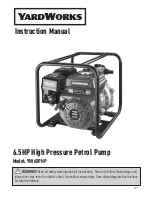
EN
ENGLISH
69
Should one or more O-rings be lost or damaged during mainte
-
nance operations on the non-return valve, they must be re
-
placed. Otherwise the system might not work correctly.
9.4 - Motor shaft
The electronic control of the system ensures smooth starts so as to avoid
excessive stress on the mechanical parts and thus prolong the life of the
product. In exceptional cases this characteristic could cause problems
Figure 21
Though essentially drained, the system is unable to expel all the
water that it contains.
During handling of the system after emptying it, some small
amounts of water may probably leak out from the system.
9.3 - Non-return valve
The system has an integrated non-return valve which is necessary for cor
-
rect operation. The presence of solid bodies or sand in the water could
cause malfunctioning of the valve and therefore of the system. Although it
is recommended to use fresh water and eventually fit filters on input, if you
notice abnormal operation of the non-return valve it can be extracted from
the system and cleaned and/or replaced by proceeding as follows:
1. remove the access door to the special maintenance compartment
(Fig.1 Face F) disengaging the 2 fixing screws with the accessory
tool. It is advisable not to remove the screws completely, so that you
can used them to extract the door. Take care not to drop the screws
inside the system once you have removed the door (Fig.21);
2. using a screwdriver, remove the 1”1/4 cap so as to access the non-
return valve (Fig.21);
3. using pliers, extract the cartridge of the non-return valve without rotat
-
ing it, gripping it by the jumper provided for the purpose (Fig.21): the
operation may require a certain effort;
4. clean the valve under running water, ensure that it is not damaged
and replace it if necessary;
5. put the complete cartridge back in its seat: the operation requires the
force necessary to compress the 2 O-Rings (Fig.21);
6. Screw on the 1”1/4 cap until it is snug: if the cartridge has not been
pushed correctly in place, screwing on the cap will complete its posi
-
tioning (Fig.21);
7. reposition the door and tighten the 2 screws (Fig.21).
















































